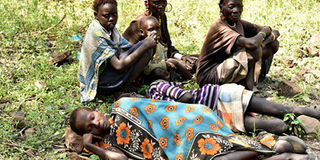Malaria deaths rise to eight as Baringo seeks aid

Malaria-afflicted residents of Kongor village in Tiaty wait for treatment in vain on August 24, 2019. PHOTO | CHEBOITE KIGEN | NATION MEDIA GROUP
What you need to know:
- Dr Toromo said preliminary laboratory tests revealed that the malaria prevalence stands at 53 per cent.
- Despite more than 20 people losing their lives to malaria in the same villages two years ago, there is still no working medical facility.
The Baringo County government has appealed for help from well-wishers and humanitarian agencies as the malaria outbreak in Tiaty continues to claim more lives.
The health department said another child succumbed to the disease on Sunday while undergoing treatment at Lomut in the neighbouring West Pokot, bringing the number of deaths to eight.
Speaking in Kabarnet, Medical Services Chief Officer Gideon Toromo said health workers had been deployed to the affected villages to combat the upsurge, but they are not enough to cover the vast area.
He noted that the response had also been hampered by a poor road network, inadequate mobile network coverage and lack of enough vehicles to reach the remote villages ravaged by the disease.
FAR-FLUNG FACILITIES
There is no single operational health facility in the entire Akoret division, and locals must walk more than 100km to Chemolingot Sub-County Hospital or Kapedo Health Centre, more than 45km away, which they cannot access now due to insecurity.
Others walk to Lomut and Sigor in West Pokot. “We have tried our level best to contain the upsurge, which has mostly affected children,” Dr Toromo said.
“We have deployed medics to the area, but the number of patients is overwhelming compared to the staff we have at the moment. Vehicles also cannot reach all the areas in the vast region.”
“Our request is to our partners, well-wishers and humanitarian agencies to support us so as to avert more deaths in the worst-hit areas,” he added.
PREVALENCE
He said preliminary laboratory tests carried out in the area revealed that the prevalence of malaria stands at 53 per cent.
He said the most affected areas are Atirir, Kapau, Chesawach and Kutol villages. “We took blood samples of 37 patients at Kongor village and 22 of them tested positive for malaria, which translates to 53 per cent,” he said.
“However, more than 400 cases have been treated. We have taken 15,000 doses of malaria to the affected areas.”
“So far, we have lost seven lives, mostly young children. But things are under control now because our team is on the ground and we also hope that more help will come,” he added.
Despite more than 20 people losing their lives to malaria in the same villages two years ago, there is still no working medical facility.





